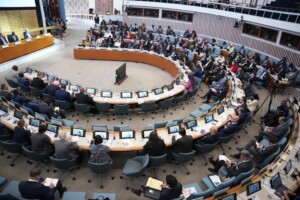Sudan OCHA bulletin 18: ‘Central Darfur must prepare for diarrhoea epidemic’
About 42,300 people were affected by heavy rains and flash floods throughout the country. International aid agencies reported the need for accelerated preparedness for Acute Watery Diarrhoea (AWD) and responses in Central Darfur. Aid reaches 1,000 displaced people who fled to El Sireaf, North Darfur, due to inter-tribal conflict in Central Darfur, the Office for the Coordination of Humanitarian Affairs (OCHA) reported in its latest biweekly bulletin.
About 42,300 people were affected by heavy rains and flash floods throughout the country. International aid agencies reported the need for accelerated preparedness for Acute Watery Diarrhoea (AWD) and responses in Central Darfur. Aid reaches 1,000 displaced people who fled to El Sireaf, North Darfur, due to inter-tribal conflict in Central Darfur, the Office for the Coordination of Humanitarian Affairs (OCHA) reported in its latest biweekly bulletin.
Heavy rains and flash floods have affected about 42,300 people in Khartoum, El Gezira, Sennar, North Darfur, South Darfur, Central Darfur, South Kordofan and White Nile states as of 13 August 2017, according to the Government of Sudan Humanitarian Aid Commission (HAC). This is significantly lower compared to the same period last year, when over 216,000 people were affected by heavy rains and flash floods.
In Khartoum, 205 homes were destroyed and 845 damaged, affecting an estimated 5,250 people. In El Gezira, 678 homes were destroyed and 79 damaged, affecting an estimated 3,785 people.
In South Kordofan, 450 homes were destroyed and 43 damaged, affecting an estimated 2,840 people. The UN Office for the Coordination of Humanitarian Affairs (OCHA) is currently following up with HAC and humanitarian partners to identify needs.
In Central Darfur, 897 homes were destroyed, affecting an estimated 4,485 people, mainly in Hamidiya and Hasahisa internally displaced persons (IDP) camps. A joint assessment by humanitarian organisations, including HAC, recommended immediate provision of emergency shelter and household supplies to all affected families in both camps.
In Sennar, 1,059 homes were destroyed and 765 were damaged, affecting an estimated 9,120 people. In response, the Sudanese Red Crescent Society (SRCS) distributed 200 pieces of plastic sheeting and readymade food, and provided support in evacuating some affected households.
In North Darfur State, 104 homes were destroyed and 128 were damaged, affecting an estimated 1,041 people. In South Darfur, 1,113 homes were destroyed and 727 damaged, affecting an estimated 9,200 people.
In White Nile state, 919 homes were destroyed and 390 were damaged, affecting an estimated 6,545 people. In response, UNHCR distributed 200 pieces of plastic sheeting, 200 kitchen utensils and 200 jerry cans.
Above average rainfall in most cropping areas of Sudan, FEWS NET
Meanwhile, according to the latest FEWS NET East Africa Seasonal Monitor Report for August 2017, seasonal rainfall in Sudan has continued to be above average during the past few weeks, which has been favourable in most cropping areas of the country.
The weekly forecasts indicate continued intensification of seasonal rainfall, with increased likelihood for flooding in flood-prone areas of eastern Sudan. However, there are localised areas in western Darfur where July rains were below average, resulting in drier-thannormal vegetation conditions.
Need for accelerated AWD preparedness, Central Darfur
In early August, a joint mission visited Central Darfur’s Nierteti and Zalingei areas to report on gaps and challenges in the Acute Watery Diarrhoea (AWD) response activities. The mission included representatives from the Federal Ministry of Health (FMoH), the World Health Organization (WHO), the UN Development Agency (UNDP), the UN Refugee Agency (UNHCR) and OCHA.
Humanitarian access and insecurity remain major challenges for the implementation of key health and protection interventions in the area. Additionally, Nierteti's hospital faces gaps in medicines, including oral and intravenous re-hydration solutions, which are needed in the treatment of AWD. The hospital also lacks an isolation ward, has staffing shortages—with just two physicians and two nurses currently on board—and lacks proper health administration and hospital management staff.
In Zalingei hospital, there are several sanitation issues, including lack of latrines and evidence of improper solid waste management, increasing the risk of vector-borne diseases, including AWD, spreading more quickly. To respond adequately and swiftly to the growing needs, the mission found that in Central Darfur, which is reporting suspected cases of AWD for the first time, six localities require isolation centres to be established as soon as possible.
Aid for 1,000 El Sireif displaced
From 1 to 3 August 2017, OCHA, UNICEF and WES carried out a fact finding and monitoring mission to North Darfur’s El Sireif locality to assess the needs of an estimated 1,000 people (215 families) newly displaced from Central Darfur’s Salayle village (Um Dukhun locality) who sought shelter in El Hariga area, approximately 3km southwest of El Sireif town. These people fled their homes following conflict between the Misseriya and the Salamat tribes which reportedly resulted in the burning of their village and the loss of most of their property and assets (food, livestock and essential household items), according to community leaders and local authorities.
According to the leaders of the displaced, they will remain in El Sireif and not return to Central Darfur. The community were originally from El Sireif area but had fled to Central Darfur over 50 years ago. They no longer have any connections with relatives in the area and are considered displaced people.











 and then
and then